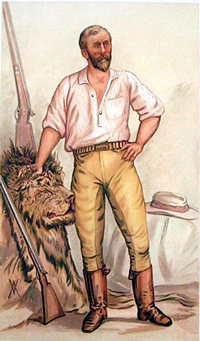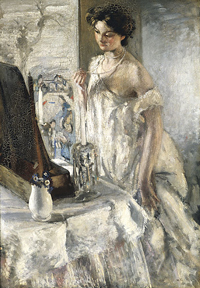
Source: Frederick Selous Vanity Fair 26 April 1894, Wikimedia
An omniscient narrator presents multiple perspectives, allowing you to think for yourself. A third-person objective narrator doesn’t tap into any of the characters’ thoughts or feelings, also allowing you to think for yourself and observe as the narrator is observing. In literature, though, many authors prefer to shape your responses. For that reason, many use a third-person limited POV. In third-person limited, the story is told by an outside narrator. The narrator gets inside the brain of one character, usually the protagonist. With a third-person limited POV, you focus on one character who shares his or her feelings, thoughts, and reactions. Your knowledge of the other characters in the work of fiction is limited to what the point-of-view character tells you.
Richard Connell chose a third-person limited narrator for his famous story “The Most Dangerous Game.” Read the thoughts of the protagonist, Rainsford, who is being hunted like an animal by General Zaroff in the passage below.
Night found him leg-weary, with hands and face lashed by the branches, on a thickly wooded ridge. He knew it would be insane to blunder on through the dark, even if he had the strength. His need for rest was imperative and he thought, “I have played the fox, now I must play the cat of the fable.” A big tree with a thick trunk and outspread branches was near by, and, taking care to leave not the slightest mark, he climbed up into the crotch, and, stretching out on one of the broad limbs, after a fashion, rested. Rest brought him new confidence and almost a feeling of security.

Source: The pearl necklace, Henry Tonks, Wikimedia
Guy de Maupassant also chose a third-person limited point of view for his clever and well-known short story “The Necklace.” Maupassant’s female protagonist, Mme. Loisel, a woman of modest means, spends one evening with her husband at an elegant reception. Here’s how she feels as she leaves this “island of wealth” wearing a new frock, a borrowed necklace, and a scruffy wrap.
He threw over her shoulders the wraps he had brought for going home, modest garments of everyday life whose shabbiness clashed with the stylishness of her evening clothes. She felt this and longed to escape unseen by the other women, who were draped in expensive furs.
The third-person limited POV most closely relates to the first-person POV in that both points of view present a subjective view of one character. The advantage in third-person limited is that you are not viewing the world through the eyes of only one character.